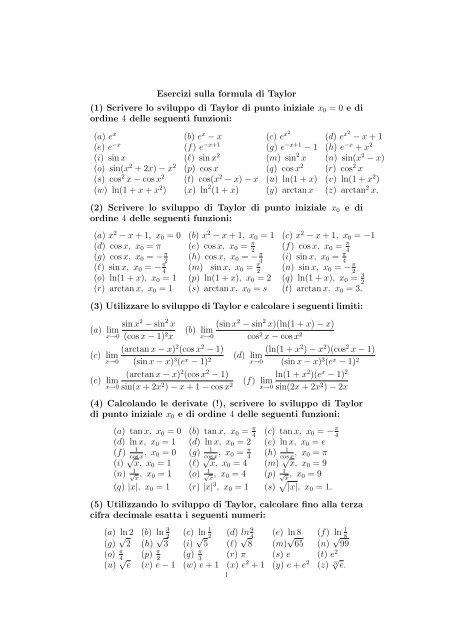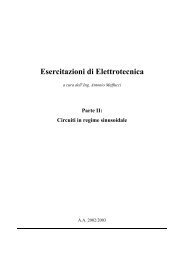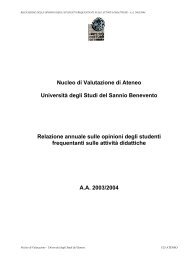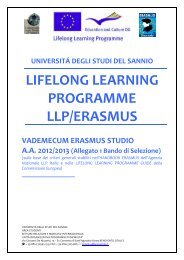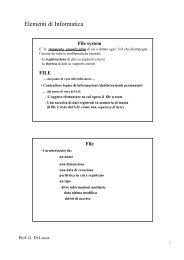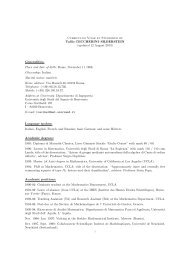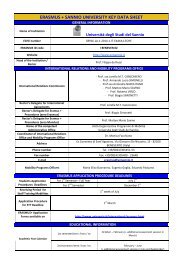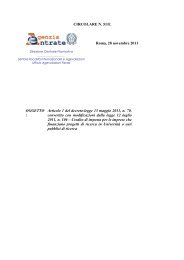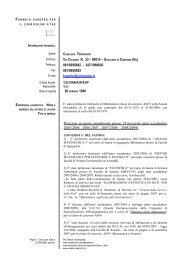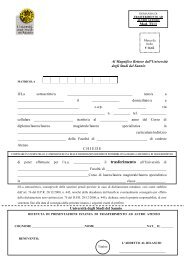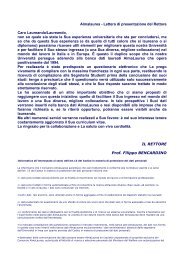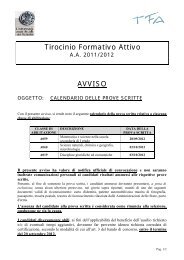Esercizi sulla formula di Taylor (1) Scrivere lo sviluppo di Taylor di ...
Esercizi sulla formula di Taylor (1) Scrivere lo sviluppo di Taylor di ...
Esercizi sulla formula di Taylor (1) Scrivere lo sviluppo di Taylor di ...
Create successful ePaper yourself
Turn your PDF publications into a flip-book with our unique Google optimized e-Paper software.
<strong>Esercizi</strong> <strong>sulla</strong> <strong>formula</strong> <strong>di</strong> <strong>Tay<strong>lo</strong>r</strong>(1) <strong>Scrivere</strong> <strong>lo</strong> <strong>sviluppo</strong> <strong>di</strong> <strong>Tay<strong>lo</strong>r</strong> <strong>di</strong> punto iniziale x 0 = 0 e <strong>di</strong>or<strong>di</strong>ne 4 delle seguenti funzioni:(a) e x (b) e x − x (c) e x2 (d) e x2 − x + 1(e) e −x (f) e −x+1 (g) e −x+1 − 1 (h) e −x + x 2(i) sin x (l) sin x 2 (m) sin 2 x (n) sin(x 2 − x)(o) sin(x 2 + 2x) − x 2 (p) cos x (q) cos x 2 (r) cos 2 x(s) cos 2 x − cos x 2 (t) cos(x 2 − x) − x (u) ln(1 + x) (v) ln(1 + x 2 )(w) ln(1 + x + x 2 ) (x) ln 2 (1 + x) (y) arctan x (z) arctan 2 x.(2) <strong>Scrivere</strong> <strong>lo</strong> <strong>sviluppo</strong> <strong>di</strong> <strong>Tay<strong>lo</strong>r</strong> <strong>di</strong> punto iniziale x 0 e <strong>di</strong>or<strong>di</strong>ne 4 delle seguenti funzioni:(a) x 2 − x + 1, x 0 = 0 (b) x 2 − x + 1, x 0 = 1 (c) x 2 − x + 1, x 0 = −1(d) cos x, x 0 = π (e) cos x, x 0 = π 2(f) cos x, x 0 = π 4(g) cos x, x 0 = − π (h) cos x, x2 0 = − π (i) sin x, x4 0 = π 4(l) sin x, x 0 = − π (m) sin x, x4 0 = π (n) sin x, x2 0 = − π 2(o) ln(1 + x), x 0 = 1 (p) ln(1 + x), x 0 = 2 (q) ln(1 + x), x 0 = 3 2(r) arctan x, x 0 = 1 (s) arctan x, x 0 = s (t) arctan x, x 0 = 3.(3) Utilizzare <strong>lo</strong> <strong>sviluppo</strong> <strong>di</strong> <strong>Tay<strong>lo</strong>r</strong> e calcolare i seguenti limiti:(a) limx→0sin x 2 − sin 2 x(cos x − 1) 2 x(c) limx→0(arctan x − x) 2 (cos x 2 − 1)(sin x − x) 3 (e x − 1) 2(e) limx→0(arctan x − x) 2 (cos x 2 − 1)sin(x + 2x 2 ) − x + 1 − cos x 2(b) limx→0(sin x 2 − sin 2 x)(ln(1 + x) − x)cos 2 x − cos x 2(d) limx→0(ln(1 + x 2 ) − x 2 )(cos 2 x − 1)(sin x − x) 3 (e x − 1) 2(f) limx→0ln(1 + x 2 )(e x − 1) 2sin(2x + 2x 2 ) − 2x(4) Calcolando le derivate (!), scrivere <strong>lo</strong> <strong>sviluppo</strong> <strong>di</strong> <strong>Tay<strong>lo</strong>r</strong><strong>di</strong> punto iniziale x 0 e <strong>di</strong> or<strong>di</strong>ne 4 delle seguenti funzioni:(a) tan x, x 0 = 0 (b) tan x, x 0 = π (c) tan x, x4 0 = − π 4(d) ln x, x 0 = 1 (d) ln x, x 0 = 2 (e) ln x, x 0 = e1(f) , x 1cos x 0 = 0 (g) , x cos x 0 = π 1(h) , x 4 cos x 0 = π(i) √ x, x 0 = 1 (l) √ x, x 0 = 4 (m) √ x, x 0 = 9(n) √ 1x, x 0 = 1 (o) √ 1x, x 0 = 4 (p) 1x, x 0 = 9(q) |x|, x 0 = 1 (r) |x| 3 , x 0 = 1 (s) √ |x|, x 0 = 1.(5) Utilizzando <strong>lo</strong> <strong>sviluppo</strong> <strong>di</strong> <strong>Tay<strong>lo</strong>r</strong>, calcolare fino alla terzacifra decimale esatta i seguenti numeri:(a) ln 2 (b) ln 3 2(c) ln 1 2(d) ln 9 4(e) ln 8 (f) ln 1 8(g) √ 2 (h) √ 3 (i) √ 5 (l) √ 8 (m) √ 65 (n) √ 99(o) π 4(p) π 2(q) π 3(r) π (s) e (t) e 2(u) √ e (v) e − 1 (w) e + 1 (x) e 2 + 1 (y) e + e 2 (z) 3√ e.1
2(6) Utilizzare <strong>lo</strong> <strong>sviluppo</strong> <strong>di</strong> <strong>Tay<strong>lo</strong>r</strong> per determinare per qualiα ∈ R i seguenti integrali impropri sono convergenti:(a)(c)(e)(g)(i)(m)(o)(q)(s)∫ 10∫ 10∫ 10∫ 10∫ 10∫ 10∫ 10∫ 10∫ 10sin x 2 − sin 2 ∫x1(cos x − 1) 2 x dx (b) α(arctan x − x) 2 (cos x 2 − 1)(sin x − x) 3α (e x − 1) 2 dx (d)0∫ 1(arctan x − x) 2 (cos x 2 − 1)sin x − x + (cos x − 1) α dx (f) ∫ 1sin x 2 − sin 2 ∫x1(cos x − 1) 2α−3 x dx (h)(arctan x − x) 2−α (cos x 2 − 1)dx (l)(sin x − x) 3α+1 (e x − 1) 2000∫ 1(arctan x − x) 2α (cos x 2 − 1)sin x 2 − x 2 + (1 − cos x) α dx (n) ∫ 1sin x 2 − sin 2 ∫x1(cos x − 1) 2 x dx (p) α(arctan x − x) 2 (cos x 2 − 1)(sin x − x) 3α (e x − 1) 2 dx (r)(arctan x − x) 2 (cos x 2 − 1)(sin(x + 2x 2 ) − x) α dx (t)000∫ 10∫ 10(sin x 2 − sin 2 x) α (ln(1 + x) − x)dxcos 2 x − cos x 2(ln(1 + x 2 ) − x 2 )(cos 2 x − 1)dx(sin x − x) 3 (e x − 1) 2−αln(1 + x 2 )(e x − 1) 2(sin 2x − 2x) α + cos(2x 2 ) − 1 dx(sin x 2 − sin 2 x) αcos 2 x − cos x dx 2(ln(1 + x 2 ) α − x 2 )(cos 2 x − 1)dx(sin x − x) 3 (e x − 1) 2ln(1 + x 2 )(e x − 1) 2(sin(2x + 2x 2 ) − 2x) α dx(sin x 2 − sin 2 x) α (ln(1 + x) − x)dxcos 2 x − cos x 2(ln(1 + x 2 ) − x 2 )(cos 2 x − 1)dx(sin x − x) 3 (e x − 1) 2−αln(1 + x 2 )(e x − 1) 2sin(2x + 2x 2 ) − 2x α dx(7) Utilizzare <strong>lo</strong> <strong>sviluppo</strong> <strong>di</strong> <strong>Tay<strong>lo</strong>r</strong> per determinare per qualiα ∈ R le seguenti serie sono convergenti:∞∑ √ 1∞∑(a) n sin (b) n α 1sinn αn 2 − nn=1n=1∞∑((c) sin 1 n − 1 ) α(1 − cos 1 nn ) (d) ∑ ∞(sin 1 − 1 n n )nα1 − cos n+1n=1n=1n 2∞∑ (tan 1 −n∞∑n(e)2 n 3 +n )αln(1 + 1 ) − 1 n(f)2 n 21 − e 1 n(cos 1 − .n 1)αn=1n=1


